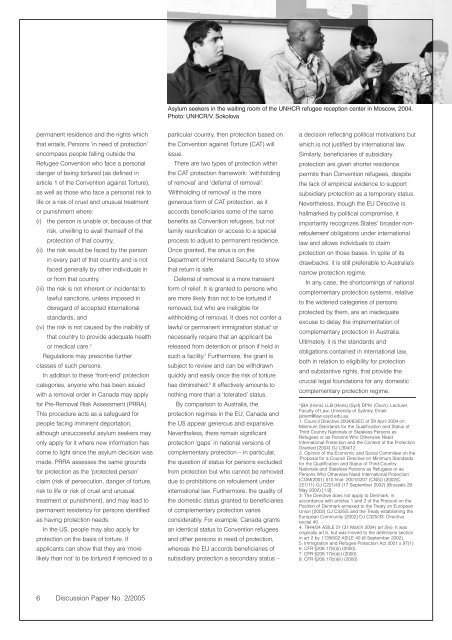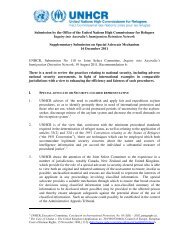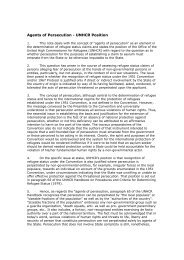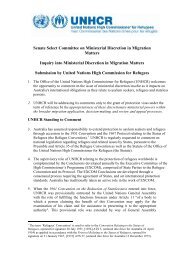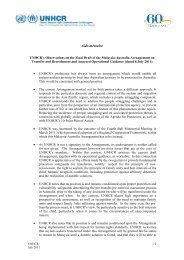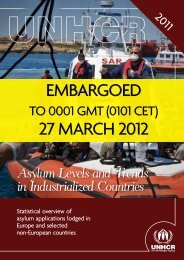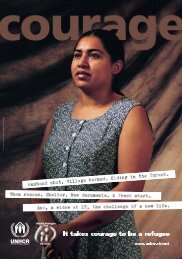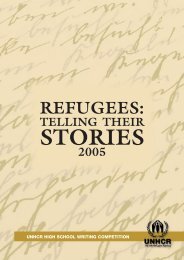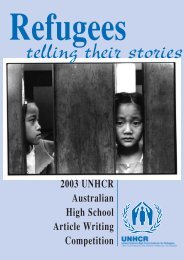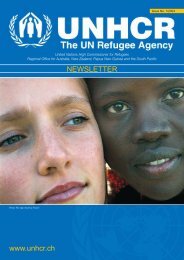Refugee Newsletter - unhcr
Refugee Newsletter - unhcr
Refugee Newsletter - unhcr
Create successful ePaper yourself
Turn your PDF publications into a flip-book with our unique Google optimized e-Paper software.
Asylum seekers in the waiting room of the UNHCR refugee reception center in Moscow, 2004.Photo: UNHCR/V. Sokolovapermanent residence and the rights whichthat entails. Persons ‘in need of protection’encompass people falling outside the<strong>Refugee</strong> Convention who face a personaldanger of being tortured (as defined inarticle 1 of the Convention against Torture),as well as those who face a personal risk tolife or a risk of cruel and unusual treatmentor punishment where:(i) the person is unable or, because of thatrisk, unwilling to avail themself of theprotection of that country,(ii) the risk would be faced by the personin every part of that country and is notfaced generally by other individuals inor from that country,(iii) the risk is not inherent or incidental tolawful sanctions, unless imposed indisregard of accepted internationalstandards, and(iv) the risk is not caused by the inability ofthat country to provide adequate healthor medical care. 5Regulations may prescribe furtherclasses of such persons.In addition to these ‘front-end’ protectioncategories, anyone who has been issuedwith a removal order in Canada may applyfor Pre-Removal Risk Assessment (PRRA).This procedure acts as a safeguard forpeople facing imminent deportation,although unsuccessful asylum seekers mayonly apply for it where new information hascome to light since the asylum decision wasmade. PRRA assesses the same groundsfor protection as the ‘protected person’claim (risk of persecution, danger of torture,risk to life or risk of cruel and unusualtreatment or punishment), and may lead topermanent residency for persons identifiedas having protection needs.In the US, people may also apply forprotection on the basis of torture. Ifapplicants can show that they are ‘morelikely than not’ to be tortured if removed to aparticular country, then protection based onthe Convention against Torture (CAT) willissue.There are two types of protection withinthe CAT protection framework: ‘withholdingof removal’ and ‘deferral of removal’.‘Withholding of removal’ is the moregenerous form of CAT protection, as itaccords beneficiaries some of the samebenefits as Convention refugees, but notfamily reunification or access to a specialprocess to adjust to permanent residence.Once granted, the onus is on theDepartment of Homeland Security to showthat return is safe.Deferral of removal is a more transientform of relief. It is granted to persons whoare more likely than not to be tortured ifremoved, but who are ineligible forwithholding of removal. It does not confer alawful or permanent immigration status 6 ornecessarily require that an applicant bereleased from detention or prison if held insuch a facility. 7 Furthermore, the grant issubject to review and can be withdrawnquickly and easily once the risk of torturehas diminished. 8 It effectively amounts tonothing more than a ‘tolerated’ status.By comparison to Australia, theprotection regimes in the EU, Canada andthe US appear generous and expansive.Nevertheless, there remain significantprotection ‘gaps’ in national versions ofcomplementary protection – in particular,the question of status for persons excludedfrom protection but who cannot be removeddue to prohibitions on refoulement underinternational law. Furthermore, the quality ofthe domestic status granted to beneficiariesof complementary protection variesconsiderably. For example, Canada grantsan identical status to Convention refugeesand other persons in need of protection,whereas the EU accords beneficiaries ofsubsidiary protection a secondary status –a decision reflecting political motivations butwhich is not justified by international law.Similarly, beneficiaries of subsidiaryprotection are given shorter residencepermits than Convention refugees, despitethe lack of empirical evidence to supportsubsidiary protection as a temporary status.Nevertheless, though the EU Directive ishallmarked by political compromise, itimportantly recognizes States’ broader nonrefoulementobligations under internationallaw and allows individuals to claimprotection on those bases. In spite of itsdrawbacks, it is still preferable to Australia’snarrow protection regime.In any case, the shortcomings of nationalcomplementary protection systems, relativeto the widened categories of personsprotected by them, are an inadequateexcuse to delay the implementation ofcomplementary protection in Australia.Ultimately, it is the standards andobligations contained in international law,both in relation to eligibility for protectionand substantive rights, that provide thecrucial legal foundations for any domesticcomplementary protection regime.*(BA (Hons) LLB (Hons) (Syd) DPhil (Oxon); Lecturer,Faculty of Law, University of Sydney. Email:janem@law.usyd.edu.au.1. Council Directive 2004/83/EC of 29 April 2004 onMinimum Standards for the Qualification and Status ofThird Country Nationals or Stateless Persons as<strong>Refugee</strong>s or as Persons Who Otherwise NeedInternational Protection and the Content of the ProtectionGranted [2004] OJ L304/12.2. Opinion of the Economic and Social Committee on the‘Proposal for a Council Directive on Minimum Standardsfor the Qualification and Status of Third-CountryNationals and Stateless Persons as <strong>Refugee</strong>s or asPersons Who Otherwise Need International Protection’(COM(2001) 510 final- 2001/0207 (CNS)) (2002/C221/11) OJ C221/43 (17 September 2002) (Brussels 29May 2002) [1.9].3. The Directive does not apply to Denmark, inaccordance with articles 1 and 2 of the Protocol on thePosition of Denmark annexed to the Treaty on EuropeanUnion [2002] OJ C325/5 and the Treaty establishing theEuropean Community [2002] OJ C325/33: Directiverecital 40.4. 7944/04 ASILE 21 (31 March 2004) art 2(e). It wasoriginally art 5, but was moved to the definitions sectionin art 2 by 11356/02 ASILE 40 (6 September 2002).5. Immigration and <strong>Refugee</strong> Protection Act 2001 s 97(1).6. CFR §208.17(b)(i) (2000).7. CFR §208.17(b)(ii) (2000).8. CFR §208.17(b)(iii) (2000).6 Discussion Paper No. 2/2005


